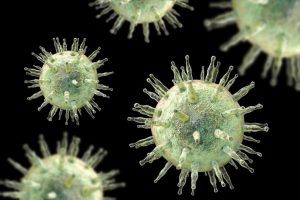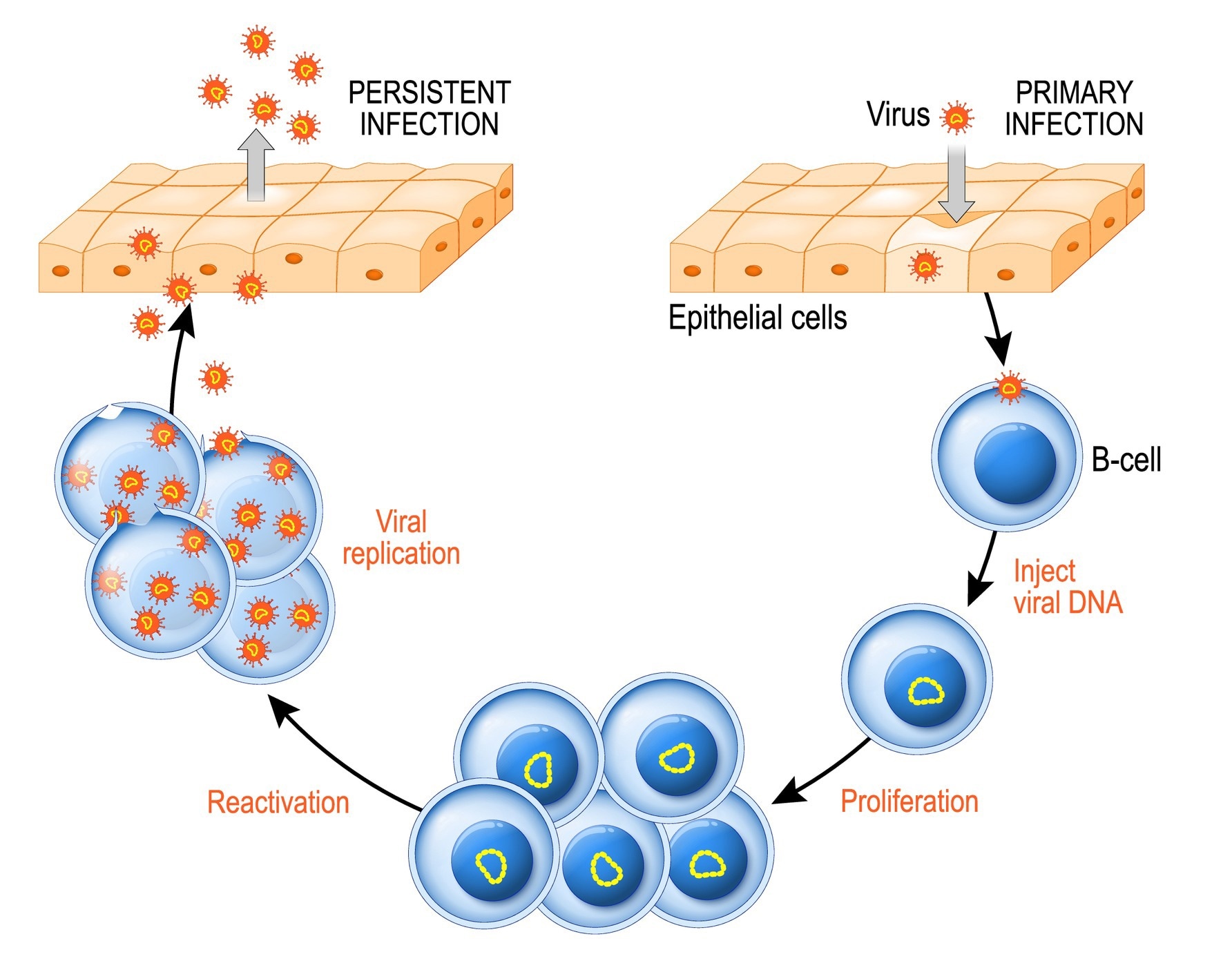Epstein-Barr virus can reactivate in long COVID

In a recent study posted to the medRxiv* preprint server, researchers at the University of California, San Francisco, and Monogram Biosciences examined the connections between the post-acute sequelae of coronavirus disease 2019 (COVID-19) (PASC) and Epstein-Barr virus (EBV) reactivation.
 Study: Evidence of recent Epstein-Barr virus reactivation in individuals experiencing Long COVID. Image Credit: Kateryna Kon / Shutterstock
Study: Evidence of recent Epstein-Barr virus reactivation in individuals experiencing Long COVID. Image Credit: Kateryna Kon / Shutterstock
Background
The biological processes underlying long COVID (LC), a kind of PASC defined by recurrent or chronic severe acute respiratory syndrome coronavirus 2 (SARS-CoV-2) infection symptoms impairing the quality of life, are presently the subject of intense research.
Latent Epstein-Barr virus (EBV), a widespread human herpes virus, is present in 90 to 95% of adults in high-income settings. Recent reports suggested the reactivation of the EBV as the cause of LC. However, there are only a few such investigations in well-defined post-acute SARS-CoV-2 groups of people with and without PASC symptoms across a time course compatible with existing case definitions of LC.
About the study
The goal of the present investigation was to determine the frequency of virological and serological evidence of EBV reactivation in a well-defined post-acute SARS-CoV-2 group of individuals without and with LC symptoms, about four months after the first COVID-19 occurrence. This allowed the researchers to evaluate the independent effects of EBV reactivation on several LC symptom categories while controlling for a range of demographic and clinical parameters, including information regarding acute infection. The team hypothesized that the cohort experiencing PASC symptoms would be enriched for indications of EBV reactivation in contrast to those who documented full recovery from COVID-19.
EBV serological assessment comprises an estimation of various antibody responses offering information regarding previous viral infections and recent viral reactivation. The authors used covariate-adjusted binary logistic regression modeling to identify the independent relationships between comorbidities, demographic variables, and EBV early antigen D (EA-D) and nuclear antigen (NA) immunoglobulin G (IgG) results with LC and across individuals with particular symptoms.
The team used plasma samples from a randomly selected subset of 50 subjects who had undergone EBV serological screening categorized by EA-D positivity for quantitative EBV polymerase chain reaction (PCR). This was to assess whether circulating EBV deoxyribonucleic acid (DNA) could be detected in the COVID-19 recovery period and if there was any correlation between PASC and EBV DNA retention.
In 294 subjects with accessible serological measures during a convalescent visit, the scientists analyzed the relationships between participant demographic characteristics, the severity of the acute COVID-19, and comorbidities. Further, they investigated the correlation between EBV antibody findings in a group of 143 people with available circulating biomarker information.
 Epstein-Barr virus life cycle. Image Credit: Designua / Shutterstock
Epstein-Barr virus life cycle. Image Credit: Designua / Shutterstock
Results
The authors found that PASC symptoms such as neurocognitive impairment and fatigue at an average of four months after initial COVID-19 diagnosis were linked to serological proof of recent EBV reactivation in a group of several hundred persons with COVID-19 history. These participants either had EBV NA IgG titers of more than 600 U/mL or EA-D IgG positivity. Besides, the investigators obtained these results after controlling for sample timing, different participant variables, underlying medical conditions, and previous hospitalization. Nevertheless, these individuals did not exhibit ongoing EBV viremia.
The team discovered a connection between serological correlates of recent EBV reactivation and hospitalization, indicating that EBV reactivation might be especially significant in severe SARS-CoV-2 infection, regularly linked to a greater prevalence of PASC. Notably, the researchers reported that PASC was also found in the minute percentage of patients with no signs of recent or past EBV infection, indicating that EBV reactivation was not a prerequisite for LC.
The authors found serological indications of recent EBV reactivation were autonomous of other inflammatory correlates. This inference again confirmed the hypothesis that EBV might have an etiological function in PASC. In addition, they discovered independent relationships between EBV EA-D IgG positivity, fatigue, and pre-existing autoimmune illness.
The scientists stated that it was unclear what biological processes were responsible for the elevated EBV NA IgG levels observed in connection with PASC symptoms. They discovered high EBV viral capsid antigens (VCA) IgG concentrations and not high NA IgG levels were linked negatively with highly symptomatic acute infection, defined as more than 10 symptoms. High VCA IgG levels present before an acute SARS-CoV-2 infection might be protective and minimize the likelihood of EBV reactivation.
Conclusions
Collectively, the present work showed that after controlling sample timing, participant variables, prior hospitalization, and concomitant diseases, LC symptoms in a post-acute SARS-CoV-2 cohort were related to serological proof of recent EBV reactivation but not with the continuing existence of EBV viremia. The team demonstrated that serological signs of recent EBV activity might lead to, at least partially, to some features of PASC.
Nonetheless, this research also emphasized that not all LC was associated with EBV. Other processes, like the persisting SARS-CoV-2 infection in different tissues, might have even more relevant functions in LC portrayed by the mounting case-series level proof that PASC symptoms drastically resolve in the context of SARS-CoV-2-targeted antiviral therapies.
The current findings add to the understanding of the connections between EBV reactivation and PASC and opine that more investigation during the acute stage of SARS-CoV-2 infection was necessary. The authors mentioned that additional research into SARS-CoV-2 and other viruses in acute infection and recovery was required to understand the underlying mechanisms of LC and develop potential treatments that could slow or stop these processes.
*Important notice
medRxiv publishes preliminary scientific reports that are not peer-reviewed and, therefore, should not be regarded as conclusive, guide clinical practice/health-related behavior, or treated as established information.
- Evidence of recent Epstein-Barr virus reactivation in individuals experiencing Long COVID; Michael J Peluso, Tyler-Marie Deveau, Sadie E Munter, Dylan Ryder, Amanda Buck, Scott Lu, Sarah A Goldberg, Rebecca Hoh, Viva Tai, Leonel Torres, Nikita S Iyer, Monika Deswal, Lynn H Ngo, Melissa Buitrago, Antonio Rodriguez, Jessica Y Chenna, Brandon C Yee, Ahmed Chenna, John W Winslow, Christos J Petropoulos, Amelia N Deitchman, Peter W Hunt, Matthew S Durstenfeld, Priscilla Y Hsue, J Daniel Kelly, Jeffrey N Martin, Steven G Deeks, Timothy J Henrich. medRxiv preprint 2022, DOI: https://doi.org/10.1101/2022.06.21.22276660, https://www.medrxiv.org/content/10.1101/2022.06.21.22276660v1
Posted in: Medical Research News | Medical Condition News | Disease/Infection News
Tags: Antibody, Antigen, Biomarker, Capsid, Chronic, Coronavirus, Coronavirus Disease COVID-19, covid-19, DNA, Epstein-Barr Virus, Fatigue, Frequency, Herpes, Immunoglobulin, Polymerase, Polymerase Chain Reaction, Research, Respiratory, SARS, SARS-CoV-2, Severe Acute Respiratory, Severe Acute Respiratory Syndrome, Syndrome, Virus

Written by
Shanet Susan Alex
Shanet Susan Alex, a medical writer, based in Kerala, India, is a Doctor of Pharmacy graduate from Kerala University of Health Sciences. Her academic background is in clinical pharmacy and research, and she is passionate about medical writing. Shanet has published papers in the International Journal of Medical Science and Current Research (IJMSCR), the International Journal of Pharmacy (IJP), and the International Journal of Medical Science and Applied Research (IJMSAR). Apart from work, she enjoys listening to music and watching movies.
Source: Read Full Article




